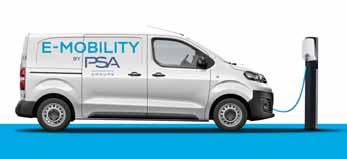
8 minute read
News
4 | NEWS I
Six nominees for International Van of the Year Award 2021
Conscious of the unprecedented times for people and businesses around the world during the Coronavirus pandemic, the annual International Van of the Year Awards go ahead in a slightly diff erent format this year.
Maxus DELIVER 9 is diesel powered, the Year Award is usually presented to the winning manufacturer at one of the two major biennial commercial vehicle shows, IAA Commercial Vehicles Show or Solutrans. However with the IA A exhibition cancelled for 2020 due to
COVID-19, the 2021 Award will instead be announced and presented virtually to the winning manufacturer.
“As the 25 strong jury membership from across Europe and Russia have been unable to travel to launch events during the lockdown period, they have had to rely on the virtual premieres presented by the various manufacturers,” explained Jarlath Sweeney, Chairman, International Van of the Year Jury. “For the adjudication process, members will be att ending drive programmes in Central Europe and where possible will also have drive experiences in their home countries. For the fi rst time, the announcement and presentation of the award is going virtual, with the trophy handover taking place on-line in mid-November at the winning brand’s
Six contenders across four brands
For the 2021 Awards programme, four light commercial vehicle brands have models nominated for the prestigious pan-European title, originally established in 1992. Interestingly for this year’s competition, only one nominee has what can be called a ‘conventional’ drivetrain, in that the new
headquarters,” he added. The prestigious International Van of whereas the other nominated vans all have electric propulsion. Th e PSA Groupe has three jointly developed contenders across its brands in the form of the Peugeot e-Expert, Citroën ë-Dispatch (e-Jumpy) and Opel/Vauxhall Vivaro-e models, while Mercedes-Benz Vans has the eSprinter and eVito in contention. Maxus, the Chinese brand from SAIC Motors, has its two newly developed vans, namely the DELIVER 9 and the zero-emission e DELIVER 3, while Fiat Professional has electrifi ed its Ducato, badged the eDucato.
The Sound of Silence with the new ë-Dispatch from Citroën
Following their unveiling on-line during May of the three charging solutions – Home, Private/Industrial or Superfast PSA Groupe’s trio of electric medium sized vans commercial. As with electric vehicles these days, the ë-Dispatch from Peugeot, Citroën and Opel, further additions harvests energy under braking and driving deceleration. to their model range (including passenger versions) have Maximum speed from the 136hp unit is governed at 130 km/h been launched. For the Citroën ë-Dispatch, the IM Group, in all three drive modes – Eco, Normal and Power. importer for the French brand through Citroën Ireland, has opened its order books in advance of production starting in First customer deliveries are expected towards the end of the September. year, or early 2021, according to Edmond Kelleher, Product Manager, Citroën Ireland. Pricing has not yet been confi rmed Available in three lengths to suit various business needs, the but Edmond mentioned that ë-Dispatch will be available in two new ë-Dispatch off ers the same advantages as the conventionally trim levels – Panel Van and Enterprise and will be specifi ed powered Dispatch van such as load volumes up to 6.6 m 3 and similar to the diesel Dispatch range. payloads up to 1262 kg. Two operating range distances can be chosen by customers – 240 km (50kW) or 340 km (100 kW) and a smooth, silent driving experience is guaranteed.
Within its compact dimensions are three length options – SWB (XS) 450 m long – 50 kW, MWB (M) 4.95 m long – 50 or 75 kW and LWB (XL) – 5.30 m – 75 kW. With an overall height of 1.90 m, the ë-Dispatch fi ts comfortably in underground car parks. Batt ery life has an 8 year warranty or 160,000 km. Th ere are

6 | NEWS II
PSA Groupe hosts VAN Live ‘e’
Xavier Peugeot, Vice President of Groupe PSA’s Business Unit for Light Commercial Vehicles (LCV) recently provided some exclusive insights into PSA’s ongoing developments of electrifi ed delivery services in urban and suburban areas, and the company’s strategy to meet and also anticipate the next societal changes and LCV market trends.
In an on-line Van Live ‘e’ interview session with members of the International Van of the Year Award Jury, hosted by Sandy Herbert, Mr. Peugeot provided more details about the fi rst of PSA’s fully electric vans and people carriers, namely the Peugeot e-Expert, Citroën ë-Dispatch and Opel/Vauxhall Vivaro-e. Th ey will, he says “make emission free business and deliveries an accessible reality.”


Th e PSA Groupe’s ambitious plan to electrify its light commercial vehicle range by the end of 2021 is still on target according to Mr. Peugeot, speaking from the Groupe’s Dome Design Centre in Paris. “About six months ago Groupe PSA announced that it would electrify 100% of its LCV range by 2021, so we are confi rming this ambition, making it concrete. Actually, we have two newcomers, an electric medium van and 9-seat electric people carrier versions.”
Asked why electric mobility so important to the LCV business, Mr. Peugeot cited its exponential growth in the coming years. “We have to keep in mind that the low emission vehicle market will be ten times bigger by 2025. It will concern all the regions of the world, and it will be true both for light commercials and passenger vehicles. So as far as Groupe PSA is concerned, we have a golden rule. We want to be 100% compliant, fully compliant with CO 2 regulations. To do so we will make sure that we can implement all the technical solutions, which will enable us to reach that target.”
“Th e second thing is that we would like Groupe PSA to be, more than ever in this current context, a mobility provider, providing freedom to mobility. And this is why we will be able to provide our customers with electric vans and passenger carriers in order to let them enter big cities, which as you know, will modify their rules and regulations regarding travel in urban cities. For LCV, it’s going to be exactly the same and I would say even more important. Th e keywords are defi nitely low emissions, CO 2 and mobility.”
He outlined the Groupe’s strategy regarding its electric LCV range. “It’s very clear – no compromise, no trade-off . One, we don’t want to electrify just one single van in the range, we would like the entire Groupe PSA LCV range to be fully electrifi ed by 2021 and this will be the case for both vans and passenger vehicles. Two, we would like this electric product off ensive to start now. And this is why for the Peugeot, Citroën, Opel and Vauxhall brands, orders will have started by the end of July with delivery in the second half of 2020. Th e third point is that we would like the performance of our electric vans to be the same as performance already known on our thermic (petrol/diesel) f l d k h ( l/d l) versions.”
But how is this to become real - to have the same benefi t and performance as the combustion engined versions? “We are mainly talking to professional customers. Th ey have a wide range of needs, a high standard of expectation, and they just want the same performances. Th is is why we will continue to provide them with a matrix of possibilities. Th ey will be able to choose the length of the van and at the same time, the version (required) - should it be a crew cab, panel van, a platform cab, this matrix will still exist in order to match their expectation.”
As mentioned earlier, there are no compromises – “One of the main assets of this medium van is its height which is 1.9m in order to let our professional customers enter city car parks. Th ey will have the same benefi ts in the electric version. But if you consider purely LCV products, the payload will still be at the high standard – up to 1,275 kg. Th e same goes for the towing load – up to 1,000 kg. Its modularity has not changed regarding usage and load capacity – up to 6.6 cubic metres.”
“In terms of customer usage, three lengths are still available and obviously our unique compact van off ers 4.6 metres in length and up to 5 cubic metres of capacity, which are exactly the same on the electric version. Th ey will be able to choose the version that is the most in line with their professional needs.”
What about their driving capabilities? “Again it’s the same recipe - no trade off on performances here either. We still off er a powerful and fun to drive electric vehicle with 136 hp, 260 Nm of torque and a top speed of 130 km/h. We off er customers double autonomy with two range (distance) options – either up to 230 km or 330 km. Why? Just simply because 83% of our customers drive on average less than 200 km a day. And we also know that 44% of them never drive more than 300 km a day. So we should also include quick charging – 80% in 30 minutes. So that’s defi nitely an electric vehicle. Zero emissions, zero noise, zero vibration.”






